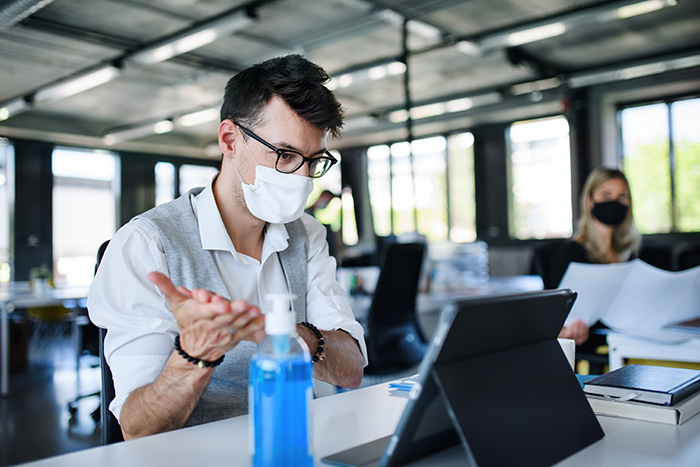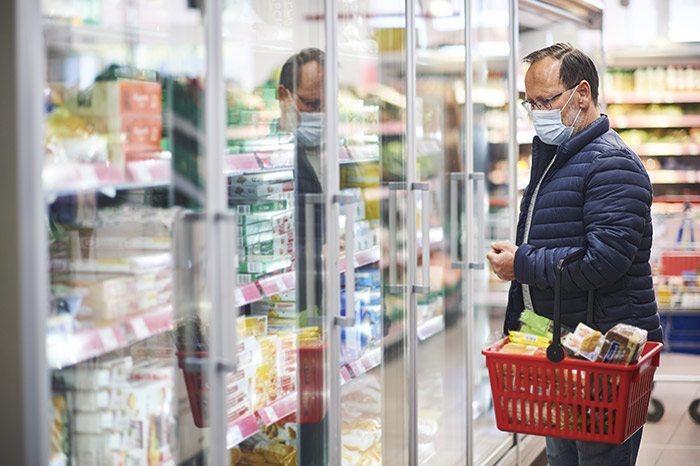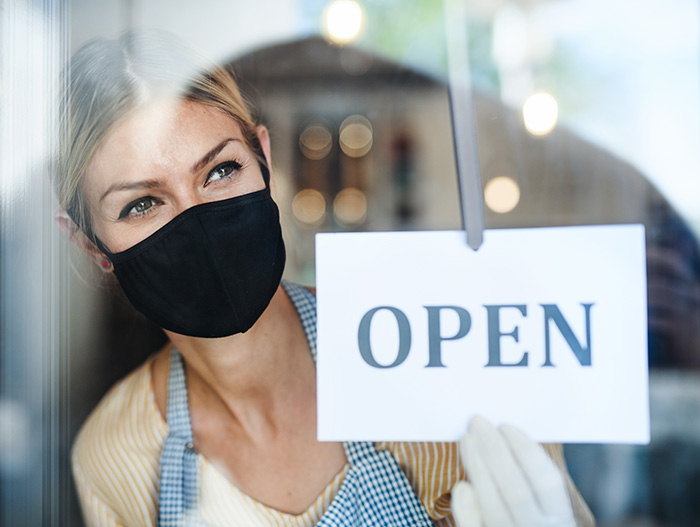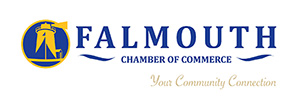
As the country begins to recover from the coronavirus pandemic and employees start heading back into an office setting, employers need to have plans in place to ensure their employees can return safely. While the crisis has made some companies adopt more robust work-from-home policies, such as the big tech giants, office spaces are rapidly evolving for the post-coronavirus era.
In fact, as companies adapt to the new normal, the modern workplace environment may see some permanent changes. As your business plans to reopen the office, these creative office space and furniture ideas will help keep your workers safe.
Rearrange existing office furniture
Right now, the top priority for businesses is to return their employees to the office as quickly and safely as possible. In this first wave of reopening (up to 50% of employees in an office at one time), companies should focus on retrofitting the workplace to align with current health guidelines.
The most immediate way to do this is to rearrange existing office furniture to ensure they comply with social distancing protocols. If possible, employees’ desks should be spaced six feet apart from each other, while other furniture can be rearranged or even removed to add more space. Social distancing can be enforced further with visual design cues to enforce the six-feet rule, as commercial real estate company Cushman & Wakefield has implemented. One-way traffic may also be enforced to keep employees from making unnecessary contact. Surfaces should also be cleaned more frequently, especially within common areas or with shared items.
Install temporary plexiglass barriers
Many businesses, such as restaurants, gas stations and grocery stores, have already installed temporary plexiglass shields and barriers to stem the spread of the coronavirus. These same barriers can be used in an office environment in areas with high foot traffic and in-person interactions. Temporary plexiglass shields can be placed in conference rooms, on employee desks or in hallways to separate people and maintain social distancing guidelines.
Repurpose communal spaces
For many businesses, large, communal spaces are going unused to comply with social distancing guidelines. These spaces include larger conference rooms, cafeterias and employee lounges. Rather than avoiding these rooms altogether, businesses can repurpose the rooms as temporary workspaces so employees can spread out.
Furthermore, if your company has space outside, you can move employees outdoors with weather permitting.
Open windows instead of turning on the air conditioner
Opening windows is the optimal way to climate-control the office while preventing the spread of coronavirus. Central air conditioners and heaters recirculate the air, which can transmit viral particles from one space to another. In contrast, opening the windows in your office will allow air to flow freely, preventing the virus from circulating through communal spaces.
While not possible for every office building, if you can, open windows around your office to climate control. If your office building does not allow you to open windows, avoid standing near the A/C exhaust, where particles are often trapped.
Purchase additional hand sanitizers
Hand washing is a simple yet effective way to mitigate the spread of coronavirus. As people return to the office, employers should consider purchasing hand sanitizer stations that are placed around common areas, such as break rooms, reception areas, entrances, conference rooms and restrooms to promote good hygiene.
If your office already has hand sanitizing stations in common areas, consider adding personal stations to employee desks. Alternatively, you can supply each worker with their own personal sanitizer each week, along with guidelines for office hand hygiene.
Enforce office capacity policies
Of course, creating distance between employees becomes easier when fewer people are in the building. Many companies are implementing a phased approach to returning people back to the office, such as staggering schedules and encouraging a mixture of remote and on-site work. Communal activities, such as buffet breakfasts and office-wide meetings, should be put on hold or modified to comply with safety regulations.
Install plastic partitions
Although temporary plastic barriers are popping up all over the countries, permanent plexiglass partitions may become the new office norm. Translucent partitions can be a useful tool to keep employees safe, while still being able to communicate freely and maintain some level of connection. This is especially useful in areas where social distancing is not feasible. Plexiglass or glass partitions may be placed in hallways or even inside elevators to minimize the risk of spreading contaminated particles. If you decide to install permanent partitions in your office, look for partitions that are made of antimicrobial materials, which self-sterilize upon contact.
While cubicles seem to be returning to popularity because of COVID-19, architects, building owners, and entrepreneurs may remove one wall in conference rooms to help promote a healthy workplace.
Reconsider cubicles
Over the past couple of decades, cubicles fell out of favor in the modern workplace and were, in many companies, replaced with open-office designs. However, the coronavirus pandemic has made people value private, personal spaces.
To help foster the feeling of an open office workplace while providing a private space for individual employees, plexiglass cubicles may replace the open office concept. While temporary plexiglass partitions are being installed all over the country, the coronavirus may be the reason why cubicles return to the office.
Turn conference rooms into ‘officles’
While cubicles seem to be returning to popularity because of COVID-19, architects, building owners, and entrepreneurs may remove one wall in conference rooms to help promote a healthy workplace. These spaces are known as “officles” because they are a cross between an office and a cubicle. Because these newly renovated spaces only have three walls, air can flow freely throughout the space and potentially prevent germs from gathering in one location.
Create conference spaces rather than rooms
While officles are one way to use transition conference spaces to the new norm, open corners of an office space can be used as a permanent, or makeshift, replacement of a closed conference room. Similar to officles, corner conference rooms promote airflow and can allow employees to spread out from one another.
Rethink the reception area
Prior to the coronavirus pandemic, most open offices offered a reception area where customers, clients or other visitors were typically greeted by an employee, then encouraged to sit or grab a cup of coffee while they waited. While this approach certainly made customers feel more comfortable and welcome, reception areas post-COVID could see a major overhaul in the next few months.
Some companies are reimagining the reception area as a decontamination lounge. New procedures, such as taking temperatures at the door, placing hand washing stations in waiting rooms, or even instructing people to take off their shoes, may become commonplace. Meanwhile, amenities that pose a higher risk of spreading germs like self-serve coffee will likely go by the wayside to reduce the risk of transmission. In its place, you may see a sink or hand-washing station that you must use before entering the office.
Update air filtration and ventilation
Coronavirus is thought to spread primarily through droplets spread when we talk, cough and breathe. While many of these droplets fall to the ground and dissipate quickly, smaller particles may linger in the air. Improving air filtration and ventilation is one way to mitigate against these tiny, potentially viral particles.
Many large businesses are poised to upgrade their HVAC systems in the near future to improve airflow and filter out contaminants.
If you don’t have the budget to replace your HVAC, portable air purifiers can be placed around the office for a fraction of the cost. This is especially useful if office windows can’t be opened to air out the space.
Source: USChamber.com





